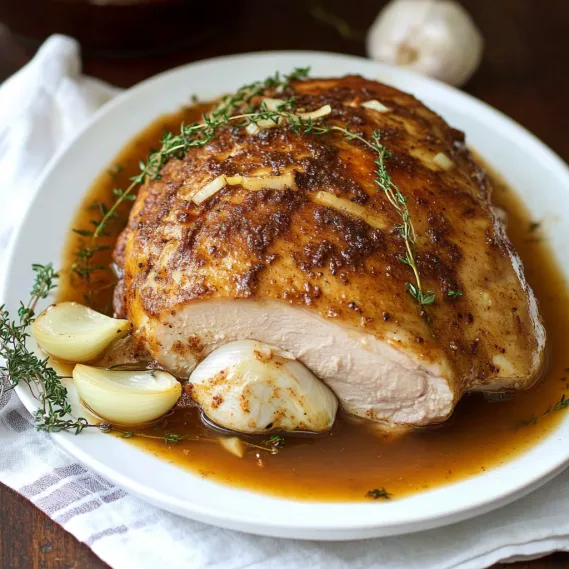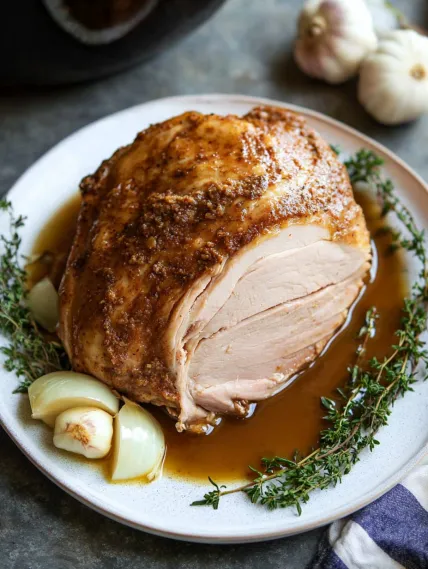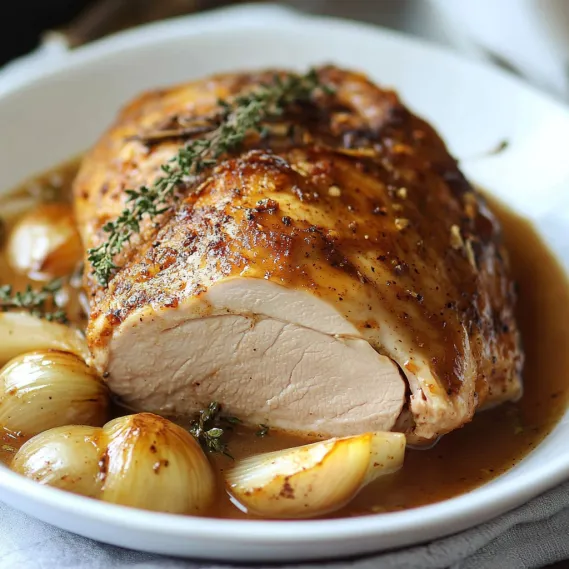 Pin
Pin
This foolproof slow cooker turkey breast delivers moist, tender meat with minimal effort and maximum flavor. The gentle, low heat of the slow cooker transforms typically lean turkey breast into a succulent centerpiece that rivals any oven-roasted version. A simple but powerful spice rub creates a flavorful crust, while a quick trip under the broiler delivers that coveted golden-brown skin. Best of all, the cooking process creates its own intensely flavored broth, which transforms into the most incredible gravy you've ever tasted. Whether you're cooking for a small holiday gathering or simply craving turkey outside of the holiday season, this recipe guarantees impressive results with almost no hands-on time.
I developed this recipe after years of disappointment with dry, bland turkey breast. The first time I served it at a small Thanksgiving gathering, my guests couldn't believe it came from a slow cooker – they insisted it was the juiciest turkey they'd ever tasted. Even my mother-in-law, who guards her traditional turkey recipe zealously, asked for the details. Now it's my signature holiday dish that everyone requests year after year.
Essential Ingredients and Selection Tips
- Turkey Breast: Either bone-in or boneless works, but skin-on is essential for flavor and moisture. Look for a plump breast with good color and no discoloration.
- Butter: Use unsalted to control the seasoning. The butter creates a rich base for the herb rub and adds moisture.
- Garlic and Onion: These aromatics serve dual purposes: flavoring the meat and elevating the turkey out of the liquid during cooking.
- Herbs: A mix of dried herbs creates depth of flavor without requiring fresh herbs. Choose the freshest dried herbs possible for best results.
- Chicken or Turkey Broth: Adds flavor and moisture. Low-sodium varieties allow better control of the final seasoning.
I've discovered through many iterations that the quality of the herbs and spices makes a significant difference in the final flavor. I now refresh my dried herbs at least twice a year to ensure they're at peak potency when holiday season arrives.
Detailed Cooking Instructions
- Step 1: Prepare The Flavor Base
- Halve one large onion and four garlic cloves, placing them cut-side down in the slow cooker. This creates a flavorful rack that elevates the turkey above the cooking liquid, allowing it to roast rather than poach while simultaneously flavoring the drippings for an incredible gravy.
- Step 2: Season For Maximum Flavor
- Mix 2 tablespoons butter with 2 teaspoons each paprika and dried thyme, 1 teaspoon each garlic powder and onion powder, and 1/2 teaspoon each salt and pepper. Pat the turkey breast dry, then rub this mixture generously all over the meat and under the skin where possible for flavor that penetrates deep into the meat.
- Step 3: Set Up For Slow Cooking
- Place the seasoned turkey breast on top of the onion and garlic, skin side up. Pour 1/2 cup chicken broth around (not over) the turkey. Cover and cook on LOW for 5-6 hours for a 4 lb turkey breast, until an internal temperature reaches 165°F/75°C at the thickest part.
- Step 4: Crisp The Skin To Perfection
- Transfer the cooked turkey to a baking sheet and broil for 3-5 minutes until the skin crisps and turns golden brown. Watch carefully to prevent burning. This step transforms the appearance and adds textural contrast to each bite.
- Step 5: Create Extraordinary Gravy
- Strain the liquid from the slow cooker into a saucepan, skimming off excess fat. Bring to a simmer and whisk in a mixture of 4 tablespoons butter and 1/4 cup flour. Cook for 2-3 minutes until thickened to coat the back of a spoon. Season to taste with salt and pepper before serving alongside the sliced turkey.

My first attempt at this recipe taught me an important lesson about patience. I initially tried to speed up the process by cooking on HIGH, but the result wasn't nearly as tender. The magic truly happens with the LOW setting, allowing the meat to cook gently and retain all its natural juices.
The Secret To Perfect Wok Technique
High heat is essential for authentic fried rice. My grandmother taught me to heat the wok until smoking before adding oil. Keep ingredients moving constantly to achieve that elusive "wok hei" flavor. Never overcrowd the pan—cook in batches instead. This technique transformed my fried rice into restaurant-quality perfection.

Making The Most Of Leftovers
This dish excels at transforming leftovers into something exciting. I've used roast chicken, holiday ham, and even Thanksgiving turkey with great success. Cut meat into uniform pieces that distribute evenly throughout. Leftover grilled steak adds incredible depth with its smoky edges. Even roasted vegetables bring delightful caramelized sweetness.
Balancing Flavors And Textures
Special fried rice succeeds through balanced components. Char siu provides richness, prawns add sweetness, eggs contribute silkiness, while vegetables offer freshness. The sequence matters—aromatics first build flavor, eggs midway remain distinct, vegetables maintain crispness. Adding spring onions last preserves their brightness for that authentic restaurant finish.
Customization For Dietary Needs
This dish adapts easily to dietary restrictions. For vegetarians, I omit meat, double eggs and add extra vegetables. Low-carb diners enjoy my cauliflower rice version that carries flavors beautifully. For gluten-sensitive guests, tamari replaces soy sauce while ensuring chicken powder is certified gluten-free. Everyone enjoys this beloved dish regardless of restrictions.
Holiday Menu Planning
This slow cooker turkey breast has revolutionized my holiday hosting strategy. Because it doesn't require oven space, I can prepare an elaborate spread of side dishes without timing conflicts. I typically start the turkey in the morning, which frees me to focus on sides and desserts throughout the day. For Thanksgiving, I pair it with traditional sides like mashed potatoes, green bean casserole, and cranberry sauce. For Christmas, I often serve it with roasted winter vegetables and Yorkshire pudding. The hands-off cooking method reduces holiday stress significantly, allowing me to actually enjoy time with guests rather than monitoring the oven constantly.
Flavor Variations To Try
While the classic herb rub creates wonderful results, I've developed several variations that have been equally successful. For Thanksgiving, try adding 1 tablespoon of maple syrup to the butter mixture for subtle sweetness. For Christmas, incorporate fresh rosemary and orange zest for a festive twist. My family particularly enjoys a southwestern version with chili powder, cumin, and a touch of lime zest added to the basic rub. For an Italian-inspired variation, use a mixture of dried basil, oregano, and a tablespoon of sun-dried tomato paste in the butter rub. These simple tweaks allow you to customize the flavor profile while maintaining the foolproof cooking method.
Perfect Timing For Various Sizes
The beauty of this recipe is its adaptability to whatever size turkey breast you have. Through multiple tests with different weights, I've developed a reliable timing chart: For a 2-3 pound breast, cook 4-5 hours on LOW. For a 4-5 pound breast, cook 5-6 hours on LOW. For larger 6-7 pound breasts, cook 6-7 hours on LOW. Remember that these are guidelines - the actual cooking time depends on your specific slow cooker and the shape of the turkey breast. Always verify doneness with a meat thermometer inserted into the thickest part, aiming for 165°F. What makes this method so forgiving is that an extra hour of cooking won't ruin your turkey - unlike oven roasting where timing is much more critical.

This Slow Cooker Turkey Breast recipe completely changed my approach to holiday cooking. What was once a stressful endeavor with uncertain results has become a relaxed, predictable process that consistently delivers impressive results. The simplicity belies the extraordinary outcome – moist, flavorful turkey and rich, savory gravy that tastes like you spent hours in the kitchen. Even kitchen novices can approach this recipe with confidence, knowing that the slow cooker's gentle heat provides a wide margin for success.
Recipe FAQs
- → Can I use a boneless, skinless turkey breast for this recipe?
- Yes, you can use boneless, skinless turkey breast, though there will be some differences in the result. Without the skin, you'll miss the crispy exterior shown in the photos, and boneless breasts tend to cook a bit faster. Start checking the internal temperature about an hour earlier than the recipe suggests. The flavor will still be excellent, but if you have the option, skin-on turkey breast is recommended for the best taste and presentation.
- → How do I know when my turkey breast is fully cooked?
- The most reliable way to know when your turkey breast is fully cooked is by using a meat thermometer. Insert it into the thickest part of the breast - the turkey is ready when it reaches an internal temperature of 165°F (75°C). If you don't have a thermometer, the meat should be white all the way through with clear juices when pierced with a fork. However, a thermometer is strongly recommended for food safety and best results.
- → Can I make this recipe for a smaller gathering or just for two people?
- Absolutely! This recipe works well with smaller turkey breasts too. For a smaller gathering, look for a single turkey breast portion that's around 1-2 pounds (0.5-1 kg). The cooking time will be shorter (about 4-5 hours on low), but the method remains the same. The leftovers also freeze well, so don't worry about making too much - you can enjoy the extras in sandwiches, salads, or soups later.
- → What if I don't have a broiler to crisp the skin?
- If you don't have a broiler (grill) function on your oven, there are alternatives for crisping the skin. You can place the cooked turkey in a regular oven at high heat (450°F/230°C) for about 10-15 minutes. Alternatively, you could heat a little oil in a large skillet and carefully sear the skin side until crispy. The skin won't be quite as evenly crisp as with the broiler method, but you'll still get a nice finish.
- → Why do you recommend not using the HIGH setting on the slow cooker?
- The LOW setting is essential for this recipe because it allows the turkey to cook gently and retain its moisture. Cooking on HIGH would cause the meat to cook too quickly and potentially dry out, defeating the purpose of using a slow cooker. The slow, gentle heat on LOW breaks down the connective tissues in the meat while keeping it juicy. Patience pays off with a much better end result!
- → Can I add vegetables to the slow cooker with the turkey?
- While you could add vegetables like carrots or celery to the bottom of the slow cooker with the onion and garlic, they may become very soft after the long cooking time. A better approach is to use those vegetables specifically for flavoring the gravy (and then strain them out), rather than as a side dish. If you want vegetables to serve alongside the turkey, it's better to cook them separately by roasting or steaming them closer to serving time for the best texture and presentation.
